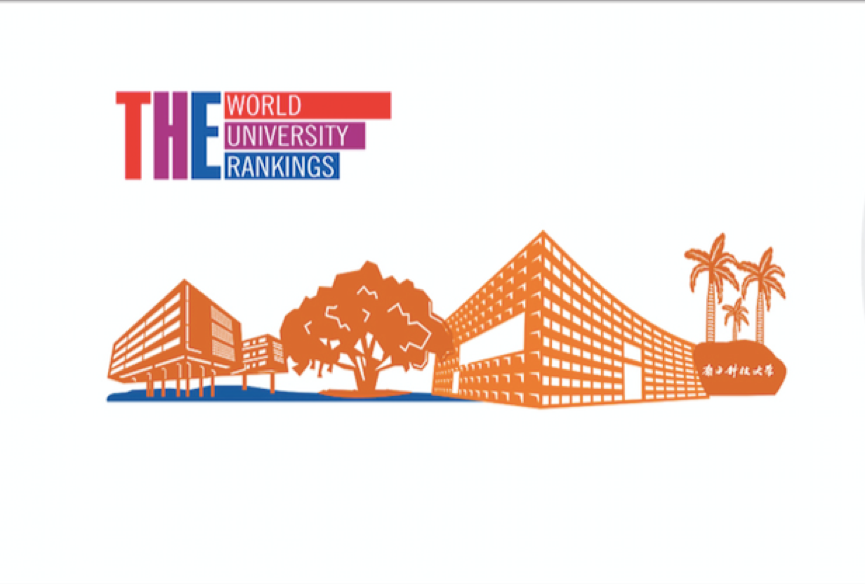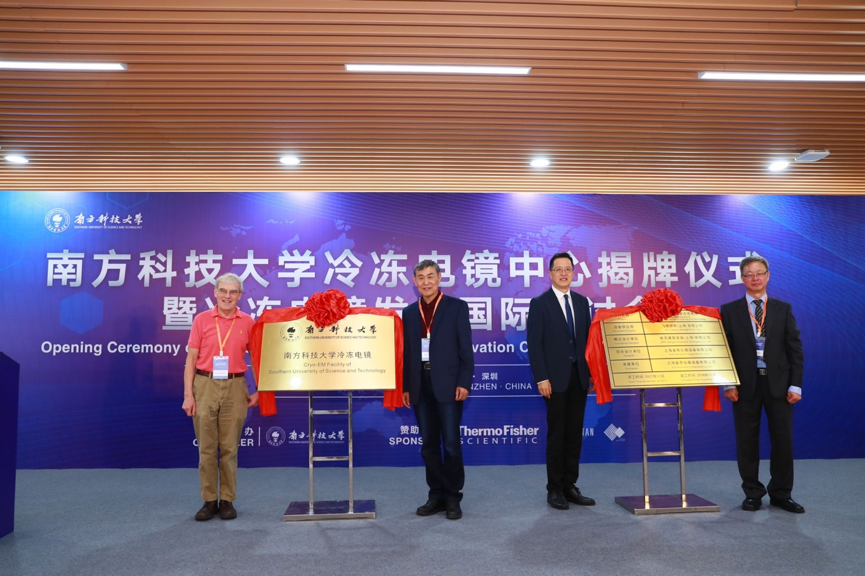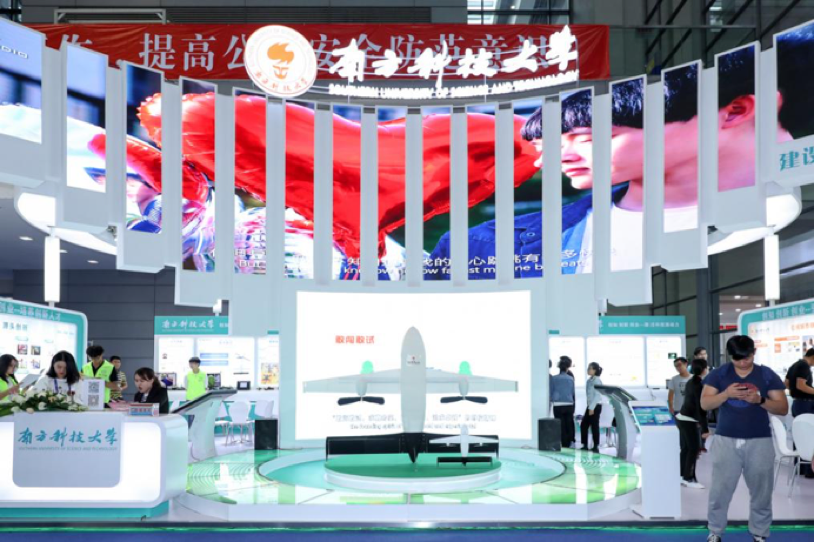In 2018, Southern University of Science and Technology (SUSTech) continued to innovate and develop in its quest to build an international high-level research university. It has made incredible progress in areas such as the publication of papers, the development of scientific research facilities and projects, the creation of its talent pipelines and the production of scientific and technological outcomes. These results show SUSTech’s influence in science and technology.
 Research impact is growing rapidly as a new star in science
Research impact is growing rapidly as a new star in science
SUSTech’s scientific research has continued to improve, year on year. Both students and faculty members were published in top scientific journals, and SUSTech was ranked highly in a wide range of domestic and international rankings.
In 2018, SUSTech faculty members published over two thousand papers in academic papers around the world, with a stable Nature Index ranking among mainland China universities. The weighted fractional count(WFC) for SUSTech in the Nature Index was 83.33, ranking 28th among mainland China universities. At the same time, both the Department of Chemistry and the Department of Materials Science and Engineering were ranked in the top 1% of the Essential Science Indicators (ESI).
In 2018, 19 papers were published in Nature, Science and Cell journals by institutions across Shenzhen. Among them, 7 were published by universities, while SUSTech had 4 such papers published, with 3 as corresponding author and 1 as co-author.
In the 2019 Times Higher Education (THE) World University Rankings, published in September 2018, SUSTech ranked 8th among in mainland China. In Nature’s Rising Star rankings, SUSTech was ranked 4th, acknowledging its increasingly prominent role in academia, both at home and abroad.
Breaking through in research
SUSTech declared over one thousand scientific research projects at all levels in 2018, and was approved for 531. It received total funding of 852 million yuan. Among the projects SUSTech was approved for, 137 projects from the National Natural Science Foundation of China (NSFC) provided 100 million yuan at an average funding rate of 33.33%. The Ministry of Science and Technology approved a further 31 projects to the tune of 84.426 million yuan.
SUSTech has also made major breakthroughs in the Ministry of Science and Technology project this year. Among them, 10 national key R&D projects have been approved, and 1 major project has been approved. The approved amount and total funding are higher than the total.
Chair Professor Yu Dapeng from the Department of Physics received funding from the NSFC-Guangdong Joint Fund Integration Project while Chair Professor Zheng Chunmiao from the School of Environmental Science and Engineering received funding for key international cooperation projects. Chair Professor Chen Yongshun from the Department of Ocean Science and Engineering received major project funding, while Professors Liu Chongxuan and Professor Zheng Yan from the School of Environmental Science and Engineering got funding for key projects.
Professor Tan Bin from the Department of Chemistry received funds from the National Science Fund for Distinguished Young Scholars of China and his colleague Associate Professor Jiang Wei was awarded the Fund for Excellent Young Scholars of China.

Development of scientific research facilities continues at great pace
2018 saw SUSTech make new progress in the development of scientific research facilities, which has resulted in the approval of four provincial and national scientific research platforms, along with four municipal research facilities, includes:
One key laboratory from the Ministry of Ecology and Environment;
One Guangdong Provincial Key Laboratory;
Two key laboratories of the Guangdong Provincial Department of Education;
One municipal engineering laboratory; and
Two municipal engineering research centers.
The construction of both the Shenzhen Institute of Quantum Science and Engineering and the Shenzhen Grubbs Institute have been advancing steadily. There has been continued development of the Aerospace Power Research Institute and the Future Networks Research Institute. 2018 saw construction start on the Science & Engineering Computing Center.
In March, the 3rd-generation semiconductor industry technology innovation strategic alliance and the 3rd-generation semiconductor research institute of Shenzhen was officially launched. It will establish an open, international and innovative institution. The innovative platform seeks to promote China’s 3rd-generation semiconductor industry to enter the advanced ranks of the world.
November saw the launch of SUSTech’s Cryo-Electron Microscop Center. With plans to install 6 sets of 300 kV cryo-electron microscopes and 71 sets of associated instruments, it will become the largest and most advanced cryo-electron microscopy center in China. In November, SUSTech’s Taiyi supercomputing cluster was ranked 127th in the world, and 1st among civilian domestic universities.
The development of these advanced research platforms have seen SUSTech promote the effective integration of interdisciplinary science across campus. By training students and faculty members on how to best take advantage of SUSTech’s plentiful resources, the scientific output in the future will continue to improve. In 2019, SUSTech will continue to make full use of the research platforms to produce higher quality scientific research results in order to benefit society.
In October, SUSTech unveiled its First and Second Affiliated Hospitals. Shenzhen Peoples Hospital and Shenzhen Third Peoples Hospital became the First Affiliated Hospital of Southern University of Science and Technology, and the Second Affiliated Hospital of Science and Technology, respectively. The rapid development of SUSTech’s medical research platforms, combined with its commitment to innovation and entrepreneurship, will ensure the best outcomes for both health care and society.
Cooperative innovation sees industry links improve further

SUSTech launch Heron UAV at 20th CHTF in Shenzhen
In 2018, SUSTech firmly grasped the opportunities found in the Guangdong-Hong Kong-Macao Greater Bay Area, which is centered on and around Shenzhen. Since the strategic emerging and future industries are centered on Shenzhen, SUSTech is playing an active role in cooperating with Hong Kong universities, industry and society to maximize the benefit to everybody.
SUSTech is involved in the promotion of full integration of government, industry, education, research and society to ensure maximum cooperation with local institutions. In this way, SUSTech can provide effective policy guidance for lawmakers, to ensure that there is good momentum for technological innovation, the development of business and the creation of talent pipelines. By creating such policy, Shenzhen has formed a talent highland, encouraging regional innovation and the development of scientific and technological achievements.
June saw a major announcement, with SUSTech combining with Hong Kong University of Science and Technology (HKUST) to unveil the SUSTech-HKUST Joint School of Microelectronics (Joint School). The Joint School seeks to serve the local economy and the development needs of the integrated circuit industry, by taking advantage of the Shenzhen integrated circuit industry. It will promote in-depth cooperation between government, industry and university to build an international high-level research-oriented national demonstration microelectronics institute.
June also saw SUSTech work with major real estate developer Kaisa to launch two new research centers. The SUSTech-Kaisa Innovation and Entrepreneurship Center and the SUSTech-Kaisa New Material Center will create interdisciplinary, industry-university collaborative platforms that seek to create business incubation and high-end technology transformation, respectively.
June also saw the unveiling of the Taizhou-Shenzhen Innovation Center. The Center will rely on the high-level scientific research achievements, along with the top scientific and technological talents of SUSTech to introduce their research achievements and represent Taizhou as their innovative open communication platform in Shenzhen.
November was also an excellent month for showing SUSTech’s scientific and technological developments. With the 20th China High Tech Fair (CHTF) taking place in Shenzhen, SUSTech had a substantial presence with nearly 30 scientific and technological innovations on display. Its flagship exhibit this year was the Heron unmanned aerial vehicle (UAV). SUSTech’s presence at these exhibits further strengthen SUSTech’s brand and industry recognition, and such a display gives SUSTech a distinctive appearance.
In early 2019, SUSTech signed a multi-party cooperative agreement with Yunnan Provincial Science and Technology Department, Beijing Institute of Collaborative Innovation and Yunnan Provincial Energy Investment Group to build an international innovation center. They also agreed to work together to create a new paradigm in industry-government-university collaboration under the Belt and Road Initiative.
In 2019, SUSTech will continue to uphold its spirit of “dare to try, be truthful and pragmatic, reform and innovate, pursue excellence.” SUSTech will strive to serve the development of an innovative China, a modern Shenzhen and a creative Greater Bay Area. Guangdong’s innovation engine shall accelerate the reform of its talent pipeline in order to make full use of its scientific research facilities and create world-class academic achievements.
Proofread ByRachel Wu, Xia Yingying
Photo ByOffice of Research